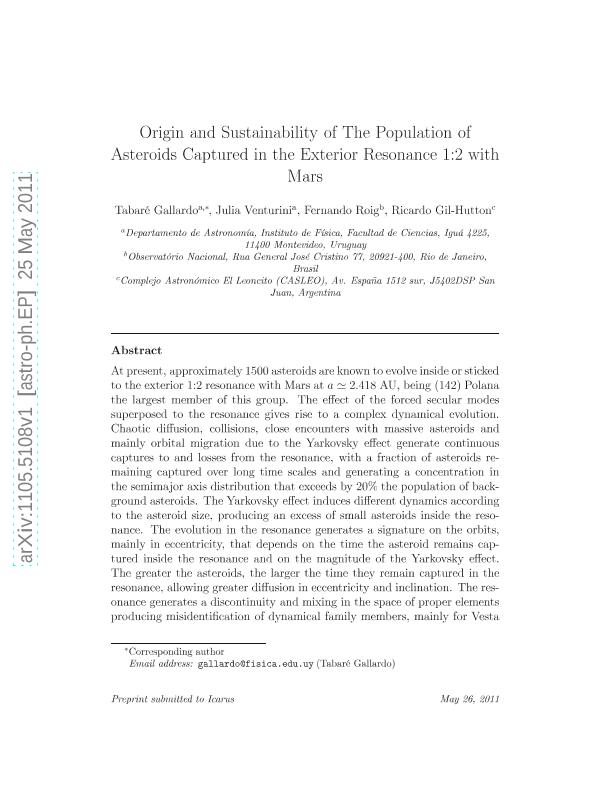Mostrar el registro sencillo del ítem
dc.contributor.author
Tabaré Gallardo, Carlos

dc.contributor.author
Venturini, Julia
dc.contributor.author
Roig, Fernando Virgilio

dc.contributor.author
Gil Hutton, Ricardo Alfredo

dc.date.available
2017-06-09T20:59:53Z
dc.date.issued
2011-08
dc.identifier.citation
Tabaré Gallardo, Carlos ; Venturini, Julia; Roig, Fernando Virgilio; Gil Hutton, Ricardo Alfredo; Origin and sustainability of the population of asteroids captured in the exterior resonance 1:2 with Mars; Elsevier; Icarus; 214; 2; 8-2011; 632-644
dc.identifier.issn
0019-1035
dc.identifier.uri
http://hdl.handle.net/11336/17943
dc.description.abstract
At present, approximately 1500 asteroids are known to evolve inside or sticked to the exterior 1:2 resonance with Mars at a ≃ 2.418 AU, being (142) Polana the largest member of this group. The effect of the forced secular modes superposed to the resonance gives rise to a complex dynamical evolution. Chaotic diffusion, collisions, close encounters with massive asteroids and mainly orbital migration due to the Yarkovsky effect generate continuous captures to and losses from the resonance, with a fraction of asteroids remaining captured over long time scales and generating a concentration in the semimajor axis distribution that exceeds by 20% the population of background asteroids. The Yarkovsky effect induces different dynamics according to the asteroid size, producing an excess of small asteroids inside the resonance. The evolution in the resonance generates a signature on the orbits, mainly in eccentricity, that depends on the time the asteroid remains captured inside the resonance and on the magnitude of the Yarkovsky effect. The greater the asteroids, the larger the time they remain captured in the resonance, allowing greater diffusion in eccentricity and inclination. The resonance generates a discontinuity and mixing in the space of proper elements producing misidentification of dynamical family members, mainly for Vesta and Nysa-Polana families. The half-life of resonant asteroids large enough for not being affected by the Yarkovsky effect is about 1 Gyr. From the point of view of taxonomic classes, the resonant population does not differ from the background population and the excess of small asteroids is confirmed.
dc.format
application/pdf
dc.language.iso
eng
dc.publisher
Elsevier

dc.rights
info:eu-repo/semantics/openAccess
dc.rights.uri
https://creativecommons.org/licenses/by-nc-nd/2.5/ar/
dc.subject
Asteroids: Dynamics
dc.subject
Asteorid Vesta
dc.subject
Resonances, Orbital
dc.subject
Rotational Dynamics
dc.subject.classification
Astronomía

dc.subject.classification
Ciencias Físicas

dc.subject.classification
CIENCIAS NATURALES Y EXACTAS

dc.title
Origin and sustainability of the population of asteroids captured in the exterior resonance 1:2 with Mars
dc.type
info:eu-repo/semantics/article
dc.type
info:ar-repo/semantics/artículo
dc.type
info:eu-repo/semantics/publishedVersion
dc.date.updated
2017-02-13T20:29:43Z
dc.journal.volume
214
dc.journal.number
2
dc.journal.pagination
632-644
dc.journal.pais
Países Bajos

dc.journal.ciudad
Amsterdam
dc.description.fil
Fil: Tabaré Gallardo, Carlos. Universidad de la República; Uruguay
dc.description.fil
Fil: Venturini, Julia. Universidad de la República; Uruguay
dc.description.fil
Fil: Roig, Fernando Virgilio. Ministério de Ciencia, Tecnologia e Innovacao. Observatorio Nacional; Brasil
dc.description.fil
Fil: Gil Hutton, Ricardo Alfredo. Consejo Nacional de Investigaciones Científicas y Técnicas. Centro Científico Tecnológico Conicet - San Juan. Complejo Astronómico "el Leoncito". Universidad Nacional de Córdoba. Complejo Astronómico ; Argentina
dc.journal.title
Icarus

dc.relation.alternativeid
info:eu-repo/semantics/altIdentifier/url/http://www.sciencedirect.com/science/article/pii/S0019103511002028
dc.relation.alternativeid
info:eu-repo/semantics/altIdentifier/doi/http://dx.doi.org/10.1016/j.icarus.2011.05.029
dc.relation.alternativeid
info:eu-repo/semantics/altIdentifier/url/https://arxiv.org/abs/1105.5108
Archivos asociados
